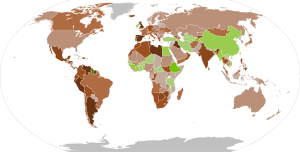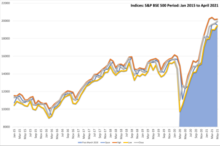
Back أثر جائحة فيروس كورونا على الاقتصاد في الهند Arabic Ekonomické dopady pandemie covidu-19 v Indii Czech भारत में कोरोनावायरस महामारी का आर्थिक प्रभाव Hindi 2019-20 കോവിഡ്-19 പകർച്ചവ്യാധിയുടെ സാമ്പത്തിക ആഘാതം ഇന്ത്യയിൽ Malayalam இந்தியாவில் பொருளாதார தாக்கம் கொரோனாவைரசுத் தொற்று Tamil భారతదేశంపై 2020 కరోనావైరస్ మహమ్మారి ఆర్థిక ప్రభావం Tegulu
This article needs to be updated. (November 2020) |
 Map showing real GDP growth rates in 2020, as projected by the IMF. | |
| Date | March 2020–December 2021 |
|---|---|
| Type | Global recession |
| Cause | COVID-19 pandemic-induced market instability and lockdown |
| Total Economic Stimulus | ₹29.87 lakh crore (equivalent to ₹35 trillion or US$440 billion in 2023) [15% of national GDP] (uptil 31 October 2020) |
| Impact |
|
The economic impact of the COVID-19 pandemic in India has been largely disruptive. India's growth in the fourth quarter of the fiscal year 2020 went down to 3.1% according to the Ministry of Statistics. The Chief Economic Adviser to the Government of India said that this drop is mainly due to the coronavirus pandemic effect on the Indian economy. Notably, India had also been witnessing a pre-pandemic slowdown, and according to the World Bank, the current pandemic has "magnified pre-existing risks to India's economic outlook".
The World Bank and rating agencies had initially revised India's growth for FY2021 with the lowest figures India has seen in three decades since India's economic liberalization in the 1990s. However, after the announcement of the economic package in mid-May, India's GDP estimates were downgraded even more to negative figures, signaling a deep recession. (The ratings of over 30 countries have been downgraded during this period.) On 26 May, CRISIL announced that this will perhaps be India's worst recession since independence. State Bank of India research estimates a contraction of over 40% in the GDP in Q1. The contraction will not be uniform, rather it will differ according to various parameters such as state and sector. On 1 September 2020, the Ministry of Statistics released the GDP figures for Q1 (April to June) FY21, which showed a contraction of 24% as compared to the same period the year before.
According to Nomura India Business Resumption Index economic activity fell from 82.9 on 22 March to 44.7 on 26 April. By 13 September 2020 economic activity was nearly back to pre-lockdown.[1] Unemployment rose from 6.7% on 15 March to 26% on 19 April and then back down to pre-lockdown levels by mid-June.[2][3] During the lockdown, an estimated 140 million (140 million) people lost employment while salaries were cut for many others.[2][4] More than 45% of households across the nation have reported an income drop as compared to the previous year.[5] The Indian economy was expected to lose over ₹32,000 crore (equivalent to ₹380 billion or US$4.7 billion in 2023) every day during the first 21-days of complete lockdown, which was declared following the coronavirus outbreak.[6][7] Under complete lockdown, less than a quarter of India's $2.8 trillion economic movement was functional.[8] Up to 53% of businesses in the country were projected to be significantly affected.[9] Supply chains have been put under stress with the lockdown restrictions in place; initially, there was a lack of clarity in streamlining what an "essential" is and what is not.[10] Those in the informal sectors and daily wage groups have been at the most risk.[11] A large number of farmers around the country who grow perishables also faced uncertainty.[10]
Major companies in India such as Larsen & Toubro, Bharat Forge, UltraTech Cement, Grasim Industries, Aditya Birla Group, BHEL and Tata Motors temporarily suspended or significantly reduced operations. Young startups have been impacted as funding has fallen.[12][13] Fast-moving consumer goods companies in the country have significantly reduced operations and are focusing on essentials. Stock markets in India posted their worst losses in history on 23 March 2020.[14] However, on 25 March, one day after a complete 21-day lockdown was announced by the Prime Minister, SENSEX and NIFTY posted their biggest gains in 11 years.[15]

The Government of India announced a variety of measures to tackle the situation, from food security and extra funds for healthcare and for the states, to sector related incentives and tax deadline extensions. On 26 March a number of economic relief measures for the poor were announced totaling over ₹170,000 crore (equivalent to ₹2.0 trillion or US$25 billion in 2023). The next day the Reserve Bank of India also announced a number of measures which would make available ₹374,000 crore (equivalent to ₹4.4 trillion or US$55 billion in 2023) to the country's financial system. The World Bank and Asian Development Bank approved support to India to tackle the coronavirus pandemic.[16]
The different phases of India's lockdown up to the "first unlock" on 1 June had varying degrees of the opening of the economy. On 17 April, the RBI Governor announced more measures to counter the economic impact of the pandemic including ₹50,000 crore (equivalent to ₹590 billion or US$7.4 billion in 2023) special finance to NABARD, SIDBI, and NHB.[17] On 18 April, to protect Indian companies during the pandemic, the government changed India's foreign direct investment policy. The Department of Military Affairs put on hold all capital acquisitions for the beginning of the financial year. The Chief of Defence Staff has announced that India should minimize costly defense imports and give a chance to domestic production; also making sure not to "misrepresent operational requirements".[18][19]
On 12 May, the Prime Minister announced an overall economic stimulus package worth ₹20 lakh crore (equivalent to ₹24 trillion or US$290 billion in 2023). Two days later the Cabinet cleared a number of proposals in the economic package including a free food grains package. In December 2020, a Right to Information petition revealed that less than 10% of this stimulus had been actually disbursed.[20] By July 2020, a number of economic indicators showed signs of rebound and recovery. On 12 October and 12 November, the government announced two more economic stimulus package, bringing the total economic stimulus to ₹29.87 lakh crore (equivalent to ₹35 trillion or US$440 billion in 2023).[21] By December 2021, India was back to pre-COVID-19 growth.[22]
| Part of a series on the |
| COVID-19 pandemic |
|---|
 |
|
|
|
- ^ "India's economic activity almost at pre-lockdown levels but Covid looms: Nomura". The Economic Times. 15 September 2020. Retrieved 15 September 2020.
- ^ a b Vyas, Mahesh (21 April 2020). "Unemployment rate touches 26%". Centre for Monitoring Indian Economy. Retrieved 24 April 2020.
- ^ Sharma, Yogima Seth (24 June 2020). "Unemployment rate falls to pre-lockdown level: CMIE". The Economic Times. Retrieved 24 June 2020.
- ^ Goyal, Malini (22 March 2020). "Covid-19: How the deadly virus hints at a looming financial crisis". The Economic Times. Retrieved 23 March 2020.
- ^ Centre for Policy Research (22 April 2022). "Podcast: How has India's lockdown impacted unemployment rates and income levels?". Scroll.in. Retrieved 24 April 2020.
- ^ "Covid-19 lockdown estimated to cost India $4.5 billion a day: Acuité Ratings". Business Line. 2 April 2020. Retrieved 11 April 2020.
- ^ PTI (25 March 2020). "Experts peg India's cost of coronavirus lockdown at USD 120 bn". The Hindu @businessline. Retrieved 25 March 2020.
- ^ "Lockdown relaxation— more than half of India's economy may reopen from Monday, says Nomura". Business Insider. Retrieved 18 April 2020.
- ^ Biman. Mukherji (23 March 2020). "Coronavirus impact: Indian industry seeks relief measures to aid economy". Livemint. Retrieved 23 March 2020.
- ^ a b Chaudhry, Siraj A. (26 March 2020). "Covid-19 puts India's food supply chain to a stress-test". The Hindu @businessline. Retrieved 26 March 2020.
- ^ Das, Goutam (30 March 2020). "136 million jobs at risk in post-corona India". Livemint. Retrieved 2 April 2020.
- ^ "Young Indian startups hit as investors get cautious". Outlook India. 1 April 2020. Retrieved 1 April 2020.
{{cite magazine}}: Unknown parameter|agency=ignored (help) - ^ Singh, Sandeep (1 April 2020). "Covid-19 Pandemic Spoils Indian Startup Funding Party, Growth Stage Worst Hit in Q1 2020". Inc42 Media. Retrieved 1 April 2020.
- ^ "Stock markets post worst losses in history; Sensex crashes 3,935 points amid coronavirus lockdown". The Indian Express. 23 March 2020. Retrieved 23 March 2020.
- ^ Shah, Ami (25 March 2020). "Sensex posts biggest gain in 11 years: Investors richer by Rs 4.7 lakh crore". The Economic Times. Retrieved 25 March 2020.
- ^ Cite error: The named reference
World Bankwas invoked but never defined (see the help page). - ^ "RBI Governor Highlights: Shaktikanta Das cuts reverse repo; pumps in money, liquidity; eases rules for banks, NBFCs". The Financial Express. 17 April 2020. Retrieved 17 April 2020.
- ^ Cite error: The named reference
The Economic Times-2020fwas invoked but never defined (see the help page). - ^ Cite error: The named reference
P-2020was invoked but never defined (see the help page). - ^ "Rs 20 lakh-crore pandemic package: Barely 10% disbursed, says RTI". The Economic Times. Indo-Asian News Service. 13 December 2021. Retrieved 14 December 2020.
- ^ Cite error: The named reference
Sharma-2020dwas invoked but never defined (see the help page). - ^ Cite error: The named reference
Hindustan Times-2021was invoked but never defined (see the help page).
© MMXXIII Rich X Search. We shall prevail. All rights reserved. Rich X Search